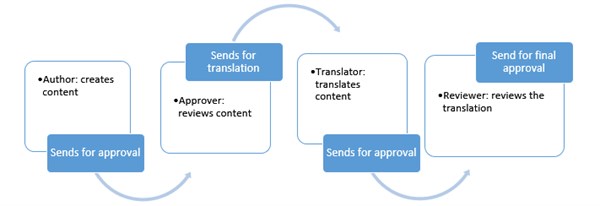Website Localization Workflows
Website localization has become very important, especially for the ecommerce industry hoping to access a wider range of global markets. Currently, most enterprise content management systems (CMS) support multilingual websites and offer a wide variety of localization features to facilitate globalization and translation. Having a solid website localization workflow in place will help you understand what your company needs to do to create a multilingual website.
Despite the importance of content localization, the process of localizing website content can be complicated. The level of complexity depends on multiple factors including:

- Content type: travel blogs, medical case studies, ecommerce product SKUs, etc.
- CMS technical details: MS .NET, Java, PHP, etc.
- Content format: text only or a combination of text, images, videos, etc.
- The level of customization of the default features of a CMS.
- The presence of a localization workflow, which I will explain in more detail below.
Localization Workflows
A localization workflow is a predefined process with the goal of organizing and executing the steps needed for content localization. A localization workflow should be considered a stand-alone process and technology independent as it should be structured based on the client needs then developed appropriately using the CMS programming language. It serves as a template which can be adjusted and fine-tuned for language and locales, content type and technology used for each translation project.
The Main Features of a Localization Workflow
There are people and processes needed for localization workflows, they are as follows:
- Users: content authors, content reviewers and approvers, technical leads, translators, project managers and desktop publishers are some of the team members who may be involved in your workflows.
- Actions: creating content, working within your CMS to format and export content for translation, reviewing translations, importing and publishing content are steps that should be a part of your plan.
- Notifications: a set of automated notifications are setup to facilitate the communication between users depending on the type of action. For example:
- An approver will receive a notification from the author after adding new content.
- A translator will receive a task notification sent by the author, for example, to translate content.
- A translator will send a notification to the content reviewer once translation is completed.
- The content approver will send a reject or approval notification after reviewing the content.

Localization Workflow Example
Summary
Creating a localization workflow will help make translating your website easier and less complicated. Putting people and plans in place before you begin will go a long way in getting the most out of your localization goals. Knowing your CMS’s multilingual capabilities when you are in the early stages of localizing will help your technical teams understand how the process of exporting and importing content for translation will work. A solid localization workflow will help your teams realize your opportunities for reaching and expanding into global markets.
